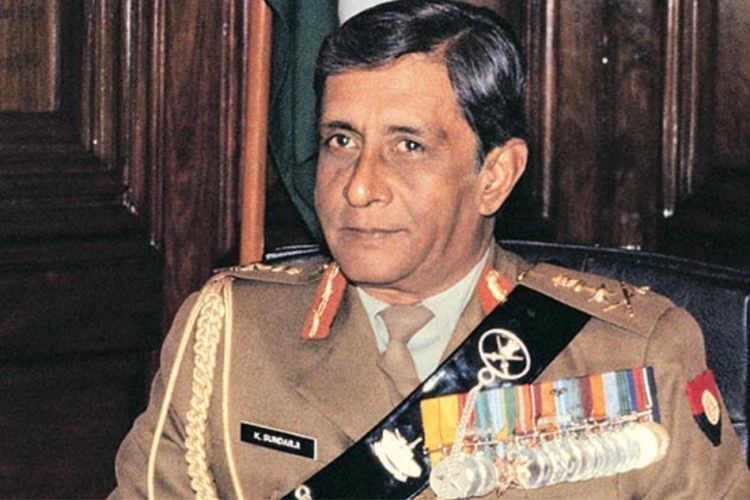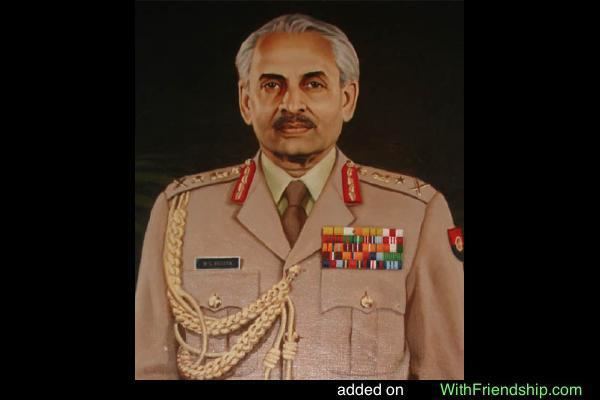Years of service 1950-1988 Service/branch Indian Army Rank General | Name Krishnaswamy Sundarji | |
 | ||
Spouse(s) Padma Sundarji (Died)Vani Sundarji Education Madras Christian College, University Of Allahabad, United States Army Command and General Staff College | ||
General Krishnaswamy Sundarji, PVSM (28 April 1930 – 8 February 1999), was the Chief of Army Staff of the Indian Army from 1986 to 1988. During his army career, he had commanded the Operation Blue Star under orders from Indira Gandhi to clear the Golden Temple shrine. This has been criticized widely as a military failure, with accusations of human rights violations. He introduced a number of technology initiatives for the Indian army. He was also questioned for his role in recommending the Bofors Howitzer in the Bofors Scandal. As the Army Chief, he planned and executed Operation Brasstacks along the Rajasthan border which was a major military exercise.
Contents
- Early life
- Life as a soldier
- The senior general
- IPKF in Sri Lanka Operation Pawan
- Sundarji as a Thinker
- Sundarji as a writer
- Death
- References

His official name was Krishnaswamy Sundararajan, but he was popularly known by the informal name of Sundarji.

Early life

He was born on 28 April 1930 at Chengelpet in Tamil Nadu. He joined the Madras Christian College only to leave it before receiving a degree.
Subsequently, he graduated from the Defence Services Staff College (DSSC) at Wellington, Tamil Nadu. He also studied at the Command and General Staff College at Fort Leavenworth in the US, and the National Defence College in New Delhi. He held a Master of Arts in International Studies from Allahabad University and an M.Sc. in Defence Studies from Madras University.
He had married Padma Sundarji when he was a Major serving with the MAHAR Regiment, an infantry Unit in the Indian Army. Padma spent the best years of her life giving him company throughout his various postings. When he was serving as General Officer Commanding (GOC), XXXIII Corps in Eastern command, she died at Army Hospital, Delhi Cantt in 1978, of cancer. He had two children, Pria and Vikram, from this marriage. Later, he married for the second time. His second wife, Vani, wrote the introductory chapter of the General Sundarji's memoirs Of some consequence - A soldier remembers, which was published after the General's death.
Life as a soldier
Even as a young soldier he proved himself to be a leader, a man of foresight and wisdom. He was commissioned in 1946 into the Mahar Regiment, where his work involved two of the most troublesome areas of North-West Frontier Province and then in Jammu and Kashmir.
In the period following India's independence (and separation of Pakistan), he was involved in action in Kargil, when a host of mercenaries supported by Pakistan invaded Kashmir.
In 1963 he served in the UN mission in the Congo, where he was chief of staff of the Katanga command and was mentioned in dispatches for his gallantry.
In 1965 he was once again back in action in India, to fight in the Indo-Pak war. This might have made Sundarji realize the crucial role, technology could play in winning wars, placed as he was in command of an Infantry battalion.
He played an important role as Brigadier General Staff of a corps in the Rangpur sector of Bangladesh, during the 1971 Indo-Pak war. This war led to the liberation of Bangladesh.
He became a Major General in 1974.For the first time in the history of Indian Army, an Infantry Officer became the General Officer Commanding (GOC) of the elite 1st Armoured Division. He was chosen by Gen. KV Krishna Rao to be part of a small team for reorganising the Indian army, especially with regard to technology. He came to head the Mechanised Infantry Regiment, which he had himself shaped, by inducting various battalions from Indian army's premier regiments.
The senior general
It was about this time when India had tested its own Nuclear bomb. General Sundarji had long been an advocate of a nuclear policy, and now emerged as an articulate military spokesman for nuclear policy.
In 1984, he led Operation Blue Star, intended to evict Sikh extremists who had occupied the Golden temple in Amritsar. The Indian army marched into the gurudawara with their boots off. He was to later say - "We went inside with humility in our hearts and prayers on our lips". According to his wife, Sundarji emerged a changed man after this operation.
In 1986, he was appointed the Chief of Army Staff. After taking over as the Army Chief, he wrote a letter to his soldiers warning of deteriorating standards, and the evil of sycophancy.
As army chief, his operations at Sumdorong Chu in 1986, known as Operation Falcon, has been widely praised. The Chinese had occupied Sumdorong Chu and Sundarji used the air force's new air-lift capability to land a brigade in Zimithang, north of Tawang. Indian forces took up positions on the Hathung La ridge, across the Namka Chu river, where India had faced a humiliating defeat in 1962. The Chinese responded with a counter-build-up and adopted a belligerent tone. Western diplomats predicted war and some of prime minister Rajiv Gandhi's advisers blamed Sundarji's recklessness. But Sundarji stood by his steps, at one point telling a senior aide, "Please make alternate arrangements if you think you are not getting adequate professional advice." The confrontation petered out.
He was also involved in Operation Brasstacks, a large-scale mechanised artillery and war gaming effort in July 1986 near the Pakistan border, which led to similar Pakistani buildup. The situation was defused through diplomatic talks in February 1987.
IPKF in Sri Lanka: Operation Pawan
In 1987, the Indian government agreed to a Sri Lankan request and the Indian Peace Keeping Force was sent to Jaffna to disarm the LTTE. However, the Indian army had no experience with the unconventional jungle warfare and faced a high rate of casualties. Among the few successes was the bombing of the LTTE controlled jetties by the Indian Navy Marine commandos (MARCOS) then known as the Indian Navy Special Commando Force.
The IPKF force was withdrawn in 1990.
Sundarji as a Thinker
Sundarji was amongst the most far-sighted armoured corps commanders in the Indian Army. Despite being commissioned in the Infantry, he was a keen student and admirer of tank warfare. He pioneered various operational guidelines, challenged his commanders to push the machines and men to the limits. In various exercises he is known to have ordered tanks full speed up sand dunes in the Thar desert at 70 degrees. Amongst other things he designed the flamboyant all black uniform of the Armoured corps.
Post his transformation of the armoured corps, Sundarji went on to create the Mechanised Infantry. With emphasis on speed, technology and mobile weaponry it is now an integral part of the Indian Strike corps.
Sundarji was amongst the core team that created Indian nuclear policy. As a senior general in the Army along with Admiral R H Tahiliani, Sundarji wrote the Indian Nuclear doctrine. Post retirement, he was unhappy with the lack of response among politicians regarding nuclear security, and wrote the book Blind Men of Hindustan in 1993.
Sundarji can also be credited for shaping modern Indian army thinking. In his stint as the Commandant of the College of Combat (now Army War College, Mhow), he practically rewrote the war manual with emphasis on speed, decisive action, technology and his abiding love - armour.
Sundarji was one of the few to predict the total rout of the (soviet trained) Iraqi forces in the first gulf war. Writing for a major Indian magazine - India Today, he was amongst the few who clearly saw what superior air power and technology would do.
Sundarji as a writer
He had other sides to his personality. He had written many articles and even a few books. His book "Blind men of Hindustan" discusses nuclear strategy for India and compares India's nuclear policy, with six blind men who misinterpret an Elephant by touching parts of it. He also left behind a partially completed autobiography titled ‘Of Some Consequence: A Soldier Remembers', of which he had completed 33 episodes out of a planned 105.
Death
He was hospitalized in March 1998. He died on 8 February 1999 at the age of 69. His son, Vikram Sundarji is a well-known author.
